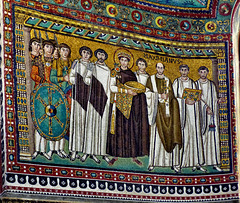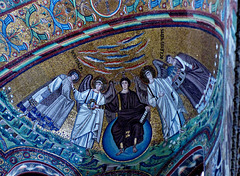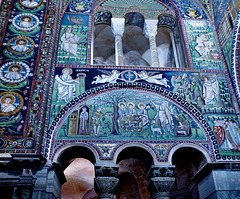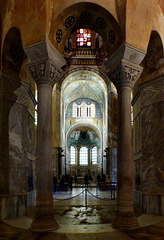
Italy
Photos taken in Italy (and Vatican State and San Marino).
Ravenna - San Vitale
| |
|
The "Basilica di San Vitale" was erected on an octagonal plan from 526 on, when Ravenna was under the rule of the Ostrogoths, followers of the Arianism. It was completed and got consecrated in 547, when Ravenna was part of the Byzantine Empire.
The church combines Roman with Byzantine elements. It is most famous for its wealth of Byzantine mosaics, the largest and best preserved outside of Constantinople. It is one of the most important examples of early Christian Byzantine art and architecture in Europe.
The impact, that this church had on the Wesern European architecture, can hardly be overestimated. The Palatine Chapel in Aachen, commisioned by Charlemagne, has strong parallels to San Vitale.
Emperor Justinian clothed in full regalia and standing in the center of a retinue of clergy, officials and soldiers (flanked on the right by Bishop Maximian) bringing the bread of the Eucharist to the altar. He has a nimbus already!
"Justinian the Great" (= Saint Justinian in the Orthodox Church) was born into a peasant´s familiy ~ 482. He made an astonishing career. He was Byzantine (East Roman) emperor from 527 to 565. He tried the empire's greatness and reconquer the lost western half of the historical Roman Empire.
Ravenna - San Vitale
| |
|
The "Basilica di San Vitale" was erected on an octagonal plan from 526 on, when Ravenna was under the rule of the Ostrogoths, followers of the Arianism. It was completed and got consecrated in 547, when Ravenna was part of the Byzantine Empire.
The church combines Roman with Byzantine elements. It is most famous for its wealth of Byzantine mosaics, the largest and best preserved outside of Constantinople. It is one of the most important examples of early Christian Byzantine art and architecture in Europe.
The impact, that this church had on the Wesern European architecture, can hardly be overestimated. The Palatine Chapel in Aachen, commisioned by Charlemagne, has strong parallels to San Vitale.
The mosaic under the dome..
Ravenna - San Vitale
| |
|
|
The "Basilica di San Vitale" was erected on an octagonal plan from 526 on, when Ravenna was under the rule of the Ostrogoths, followers of the Arianism. It was completed and got consecrated in 547, when Ravenna was part of the Byzantine Empire.
The church combines Roman with Byzantine elements. It is most famous for its wealth of Byzantine mosaics, the largest and best preserved outside of Constantinople. It is one of the most important examples of early Christian Byzantine art and architecture in Europe.
The impact, that this church had on the Wesern European architecture, can hardly be overestimated. The Palatine Chapel in Aachen, commisioned by Charlemagne, has strong parallels to San Vitale.
The mosaic of the apse depicting the garden Eden (watered by four rivers), in which (young and beardless) Christ, seated on a blue sphere and holding seven seals, is flanked by two angels. To the right is Bishop Ecclesius offering a model of the church, to the left Vitalis who is about to be crowned by Christ as a martyr.
Ravenna - San Vitale
| |
|
|
The "Basilica di San Vitale" was erected on an octagonal plan from 526 on, when Ravenna was under the rule of the Ostrogoths, followers of the Arianism. It was completed and got consecrated in 547, when Ravenna was part of the Byzantine Empire.
The church combines Roman with Byzantine elements. It is most famous for its wealth of Byzantine mosaics, the largest and best preserved outside of Constantinople. It is one of the most important examples of early Christian Byzantine art and architecture in Europe.
The impact, that this church had on the Wesern European architecture, can hardly be overestimated. The Palatine Chapel in Aachen, commisioned by Charlemagne, has strong parallels to San Vitale.
Ravenna - San Vitale
| |
|
The "Basilica di San Vitale" was erected on an octagonal plan from 526 on, when Ravenna was under the rule of the Ostrogoths, followers of the Arianism. It was completed and got consecrated in 547, when Ravenna was part of the Byzantine Empire.
The church combines Roman with Byzantine elements. It is most famous for its wealth of Byzantine mosaics, the largest and best preserved outside of Constantinople. It is one of the most important examples of early Christian Byzantine art and architecture in Europe.
The impact, that this church had on the Wesern European architecture, can hardly be overestimated. The Palatine Chapel in Aachen, commisioned by Charlemagne, has strong parallels to San Vitale.
Here are Abraham and his wife Sarah.
Genesis 18:1-10
"The Lord appeared to Abraham near the great trees of Mamre while he was sitting at the entrance to his tent in the heat of the day. Abraham looked up and saw three men standing nearby. When he saw them, he hurried from the entrance of his tent to meet them and bowed low to the ground.
He said, "If I have found favor in your eyes, my lord, do not pass your servant by. Let a little water be brought, and then you may all wash your feet and rest under this tree. Let me get you something to eat, so you can be refreshed and then go on your way—now that you have come to your servant."
"Very well," they answered, "do as you say."
So Abraham hurried into the tent to Sarah. "Quick," he said, "get three seahs of the finest flour and knead it and bake some bread."
Then he ran to the herd and selected a choice, tender calf and gave it to a servant, who hurried to prepare it. He then brought some curds and milk and the calf that had been prepared, and set these before them. While they ate, he stood near them under a tree.
"Where is your wife Sarah?" they asked him.
"There, in the tent," he said.
Then one of them said, "I will surely return to you about this time next year, and Sarah your wife will have a son."
Now Sarah was listening at the entrance to the tent, which was behind him."
Ravenna - San Vitale
| |
|
|
The "Basilica di San Vitale" was erected on an octagonal plan from 526 on, when Ravenna was under the rule of the Ostrogoths, followers of the Arianism. It was completed and got consecrated in 547, when Ravenna was part of the Byzantine Empire.
The church combines Roman with Byzantine elements. It is most famous for its wealth of Byzantine mosaics, the largest and best preserved outside of Constantinople. It is one of the most important examples of early Christian Byzantine art and architecture in Europe.
The impact, that this church had on the Wesern European architecture, can hardly be overestimated. The Palatine Chapel in Aachen, commisioned by Charlemagne, has strong parallels to San Vitale.
The mosaic, below the triforium, depicts Abel and Melchizedek bringing their offerings to the altar. God´s accepting hand is above the altar. On the adjoining spandrals are Isaiah (upper right) and Moses loosening his sandals before the Burning Bush (upper left).
Ravenna - San Vitale
| |
|
|
The "Basilica di San Vitale" was erected on an octagonal plan from 526 on, when Ravenna was under the rule of the Ostrogoths, followers of the Arianism. It was completed and got consecrated in 547, when Ravenna was part of the Byzantine Empire.
The church combines Roman with Byzantine elements. It is most famous for its wealth of Byzantine mosaics, the largest and best preserved outside of Constantinople. It is one of the most important examples of early Christian Byzantine art and architecture in Europe.
The impact, that this church had on the Wesern European architecture, can hardly be overestimated. The Palatine Chapel in Aachen, commisioned by Charlemagne, has strong parallels to San Vitale.
Pisignano - Pieve di Santo Stefano
| |
|
Where the church is now, was a temple where worshippers of Mithras met in Roman times. Ruins of the pagan place got excavated - and some parts were reused, when the church got erected within the 10th century.
During the Battle of Ravenna (1512), fought by forces of the (Spanish-Papal) Holy League and France, lead by Gaston de Foix, who died in that battle, the church got severly damaged. It got rebuilt and consecrated again in 1527.
Savignano sul Rubicone - Pieve di San Giovanni in…
| |
|
A church, dedicated to "San Giovanni", existed here already in the 7th century. The church of today was erected in the 11th century. I had learned, that some interesting spolia from Roman and Byzantine times got reused here, but the church was locked. As I arrived here on a monday, the neighbouring "Museo Archeologico di S. Giovanni in Compito" was closed as well.
The town "Savignano sul Rubicon" was named "Savignano di Romagna" upto the 1990s, when it was proven, that the river Fiumicino, which crosses the town, once was the River Rubicon, famous for Julius Caesar's historic crossing.
www.museodelcompito.com/ENG/index.asp
Santarcangelo di Romagna - Pieve di San Michele Ar…
| |
|
|
The "Pieve di San Michele Arcangelo" (dedicated to Maria Assunta) is known since the 9th century. Excations have proved, that the apse was erected over a Roman temple within the 6th century, when the area was part of the (Byzantine) Exarchate of Ravenna. By now it is the oldest church in and around Rimini.
The tower was added to the basilica within the 13th century. Unfortunately the church as locked.
San Marino
| |
|
San Marino is located on the slopes of the Monte Titano. The town is the capital of the Republic of San Marino (= Repubblica di San Marino), an enclaved microstate surrounded by Italy. The Republic of San Marino has an area of about 61km² and a population of about 33.000.
It is probably incorrect to add this photo to the album "Emilia-Romagna"... but I did.
Badia Prataglia - Santa Maria Assunta e San Bartol…
| |
|
"Santa Maria Assunta e San Bartolomeo" is the last remaining structure of an abbey, founded in 986 by Benectian monks from Montcassino. In 1008 the church of the abbey was consecrated by Elemperto, Bishop of Arezzo.
In Camaldoli, only about six kilometers west another abbey was founded in 1012 by Saint Romuald, a Benedictine hermit. The rise of the order of the (still existing) Camaldolese created conflicts between the two convents, that lasted for centuries.
The parish church of today is the result of numerous alterations, but the interior is still Romanesque. Under the risen choir is a crypt. This crypt, renovated in the early 20th century, is for sure the oldest part of the church. It surely existed around 1000, but it is claimed, that it existed already in the 6th century and was built over a Roman temple.
A person arms up in the gesture of orant and a row of knots and circles, near the niche, where probably the relics were stored.
Badia Prataglia - Santa Maria Assunta e San Bartol…
| |
|
"Santa Maria Assunta e San Bartolomeo" is the last remaining structure of an abbey, founded in 986 by Benectian monks from Montcassino. In 1008 the church of the abbey was consecrated by Elemperto, Bishop of Arezzo.
In Camaldoli, only about six kilometers west another abbey was founded in 1012 by Saint Romuald, a Benedictine hermit. The rise of the order of the (still existing) Camaldolese created conflicts between the two convents, that lasted for centuries.
The parish church of today is the result of numerous alterations, but the interior is still Romanesque. Under the risen choir is a crypt. This crypt, renovated in the early 20th century, is for sure the oldest part of the church. It surely existed around 1000, but it is claimed, that it existed already in the 6th century and was built over a Roman temple. Maybe the two marble capitals are spolia from that temple.
Badia Prataglia - Santa Maria Assunta e San Bartol…
| |
|
"Santa Maria Assunta e San Bartolomeo" is the last remaining structure of an abbey, founded in 986 by Benectian monks from Montcassino. In 1008 the church of the abbey was consecrated by Elemperto, Bishop of Arezzo.
In Camaldoli, only about six kilometers west another abbey was founded in 1012 by Saint Romuald, a Benedictine hermit. The rise of the order of the (still existing) Camaldolese created conflicts between the two convents, that lasted for centuries.
The parish church of today is the result of numerous alterations, but the interior is still Romanesque. Under the risen choir is a crypt.
Badia Prataglia - Santa Maria Assunta e San Bartol…
| |
|
"Santa Maria Assunta e San Bartolomeo" is the last remaining structure of an abbey, founded in 986 by Benectian monks from Montcassino. In 1008 the church of the abbey was consecrated by Elemperto, Bishop of Arezzo.
In Camaldoli, only about six kilometers west another abbey was founded in 1012 by Saint Romuald, a Benedictine hermit. The rise of the order of the (still existing) Camaldolese created conflicts between the two convents, that lasted for centuries.
The parish church of today is the result of numerous alterations.
Campiano - Pieve di San Cassiano in Decimo
| |
|
The parish of Campiano, in the outskirts of Ravenna, has this wonderful 12th century church and a very friendly pastor, who opened the church for us. The massive campanile with the mullioned windows is called "la Bartolla" locally.
Ravenna - San Vitale
| |
|
The "Basilica di San Vitale" was erected on an octagonal plan from 526 on, when Ravenna was under the rule of the Ostrogoths, followers of the Arianism. It was completed and got consecrated in 547, when Ravenna was part of the Byzantine Empire.
The church combines Roman with Byzantine elements. It is most famous for its wealth of Byzantine mosaics, the largest and best preserved outside of Constantinople. It is one of the most important examples of early Christian Byzantine art and architecture in Europe.
The impact, that this church had on the Wesern European architecture, can hardly be overestimated. The Palatine Chapel in Aachen, commisioned by Charlemagne, has strong parallels to San Vitale.
Ravenna - San Vitale
| |
|
|
The "Basilica di San Vitale" was erected on an octagonal plan from 526 on, when Ravenna was under the rule of the Ostrogoths, followers of the Arianism. It was completed and got consecrated in 547, when Ravenna was part of the Byzantine Empire.
The church combines Roman with Byzantine elements. It is most famous for its wealth of Byzantine mosaics, the largest and best preserved outside of Constantinople. It is one of the most important examples of early Christian Byzantine art and architecture in Europe.
The impact, that this church had on the Wesern European architecture, can hardly be overestimated. The Palatine Chapel in Aachen, commisioned by Charlemagne, has strong parallels to San Vitale.
Jump to top
RSS feed- Latest items - Subscribe to the latest items added to this album
- ipernity © 2007-2024
- Help & Contact
|
Club news
|
About ipernity
|
History |
ipernity Club & Prices |
Guide of good conduct
Donate | Group guidelines | Privacy policy | Terms of use | Statutes | In memoria -
Facebook
Twitter


















